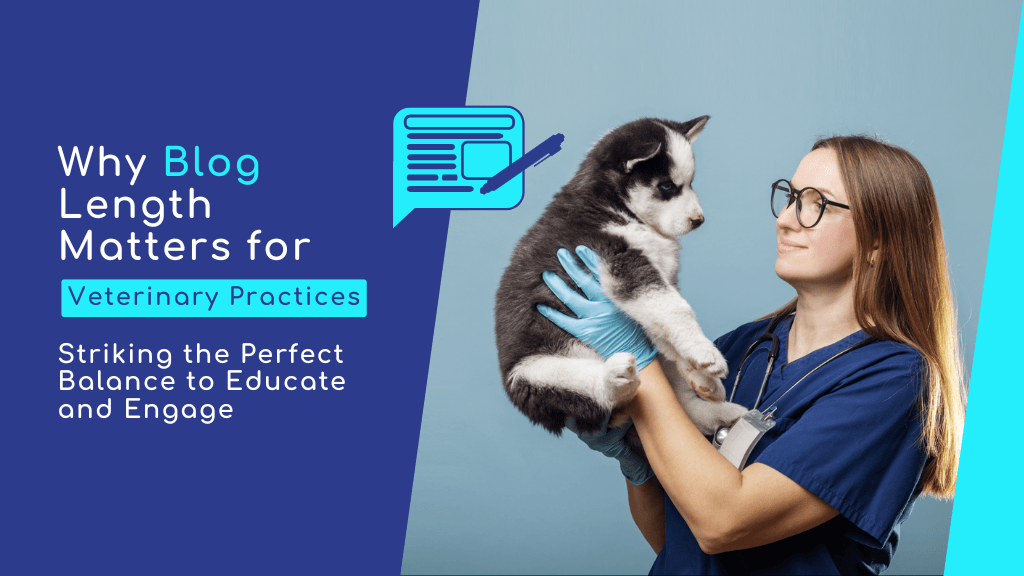Why Blog Length Matters for Veterinary Practices: Striking the Perfect Balance to Educate and Engage
)
Why Blogs Are More Than Just Words
For veterinary practices, blogs serve as a vital tool for connecting with pet owners, educating them about animal care, and building trust in your expertise. They’re not just about adding text to your website—they play a critical role in growing your online presence, attracting new clients, and keeping current ones engaged.
Google rewards websites that regularly update their content, ranking them higher in search results. For veterinary clinics, this means more visibility for your services, whether it's preventive care, pet nutrition advice, or seasonal tips for keeping pets healthy.
Beyond SEO, blogs allow you to showcase your expertise, share heartwarming stories about the pets you’ve helped, and provide actionable advice for pet owners. Blogs also make it easy to repurpose content into email newsletters, driving traffic back to your website, or turning posts into snippets for your social media channels. This maximises engagement across platforms while continually reminding your audience of your practice’s value.
The Ideal Blog Length: Backed by Veterinary-Focused Insights
When it comes to blog length, there’s no universal answer. However, veterinary practices can benefit from data-backed strategies to determine the best approach for their audience and goals.
1. General Performance
The average blog post length is approximately 1,427 words, highlighting a growing preference for more comprehensive content (SEMrush).
Blogs between 1,500-2,500 words consistently perform best in terms of traffic, engagement, and SEO rankings (WGC).
For veterinary practices, this means using longer blogs to provide in-depth resources. For instance, a 1,800-word guide on “The Complete Puppy Care Checklist” could cover vaccinations, diet, exercise, and training tips in one valuable resource. This encourages pet owners to save, share, and refer back to your content. And provides a valuable resource you can direct your clients to when they bring in a new puppy.
2. SEO Sweet Spot
Blogs between 2,100-2,400 words rank highest on Google because they provide detailed coverage of a topic (MasterBlogging).
Long-form content exceeding 3,000 words often attracts more backlinks and performs well as evergreen content (SEMrush).
Veterinary practices can leverage this by creating comprehensive resources, such as “Everything You Need to Know About Pet Allergies,” detailing symptoms, treatments, and prevention. This positions your practice as a trusted authority, can encourage people as to when to bring the pet into the practice, while also improving your SEO rankings. It could also provide a valuable resource to send to clients, aligned to a current case.
3. Audience Engagement
Shorter blogs (500-800 words) are ideal for quick updates, great for reposting a teaser on GBP and Social Media.
Blog formats such as lists, “how-to” posts, and guides consistently outperform others, regardless of length (Orbit Media).
To be honest most of our client blogs are around the 800 mark - as the typical tips would be too stretched if expanded. And as a bonus many have really good organic traffic coming to them, even at that length, due to the long tail searches people are doing within google - “why is my dog scratching so much?”
For example, a concise post like “5 Tips for Keeping Pets Cool in Summer” can drive engagement during seasonal campaigns. Adding internal links to related topics, such as heatstroke symptoms in pets, encourages further exploration of your website.
Investing time upfront in creating detailed, high-value content pays dividends over time. A well-researched article on “The Benefits of Annual Pet Checkups” can continue attracting pet owners to your practice months or even years after publication. And be a great referral post to share with new clients.
Top tip: I suggest you interview one of your Vets in an online meeting, using AI to transcribe the content, then put that into your AI tool as your base for it to help you put together the full post.
Why Blog Length Matters for Veterinary Practices
Search Engines Reward Depth
Google’s algorithms favour comprehensive content that covers topics thoroughly. Veterinary blogs with longer posts offer more opportunities to use targeted keywords, link to internal resources, and provide detailed answers to pet owners’ questions.
For example, a blog on “Understanding Feline Diabetes” could cover causes, symptoms, management, and treatment options, increasing its chances of ranking for multiple search queries.
Builds Trust and Authority
Longer blogs allow veterinary practices to showcase their expertise in animal health, building trust with pet owners. Sharing real-life examples or case studies of successful treatments can further reinforce your credibility.
Encourages Engagement
Detailed content keeps readers on your site longer, improving engagement metrics that are critical for SEO. Using relatable stories, engaging visuals (such as photos of pets), and a conversational tone helps forge a stronger connection with your audience.
Using AI to Write Veterinary Blogs
AI tools like ChatGPT and Gemini can revolutionise the way veterinary practices create content, but they’re most effective when used as an extension of your creativity. Here’s how to use AI thoughtfully:
Start with a Clear Plan: Outline your blog’s structure and key messages. Identify your audience—pet owners, veterinary professionals, or both—and decide on the topic’s goal, such as educating pet owners or promoting a specific service.
Use AI for Inspiration: AI can help brainstorm blog ideas, generate outlines, or draft specific sections. For example, you could ask it for a list of blog topics about senior pet care or catchy headlines like “10 Signs Your Pet Needs a Checkup.” Or use the top tip further up the page on interviewing an expert, or talking to yourself and recording the output, to then put into an AI tool.
Make creating good content faster: As covered previously, a top tip is to interview one of your Vets online (or talk to ChatGPT yourself) and get it to transcribe your recording, to use it as a base for the full article.
Refine the Output: Avoid relying on AI to produce your entire blog verbatim. Review and edit sections of the AI-generated content to ensure it aligns with your voice, style, and brand. Add personal insights, examples, and a unique perspective to make the content your own.
I often copy it into a Google Doc or Word, to edit it with my thoughts - then cut and paste it back into the tool to get AI to then write the intro paragraph and headlines after I am happy with the output.Fact-Check and Verify: While AI is a helpful tool, it can sometimes produce outdated or inaccurate information. Always cross-check facts, especially for medical content.
Enhance SEO: Use AI to identify SEO-friendly keywords that align with your veterinary services. Incorporate these naturally into your text without overloading your content.
Tailoring Blog Length to Veterinary Goals
To maximise impact, consider your audience’s needs and objectives:
For SEO: Aim for 2,000+ words to improve rankings and attract backlinks for at least 1 blog per month.
For Quick Tips/promotions: Write 500-800-word posts that provide immediate value, such as more details on this months promotion/offer, quick top tips.
For Comprehensive Guides: Use 1,500-3,000 words to dive deeply into complex topics like pet nutrition or preventive care.
A mix of short and long blogs ensures your content strategy caters to different audience preferences while boosting engagement.
Practical Tips for Writing Engaging Veterinary Blogs
Structure for Readability: Use headings, bullet points, and visuals to make long-form content easy to digest.
Focus on Value: Ensure each section addresses your audience’s needs, from pet care tips to disease prevention.
Repurpose Content: Break longer blogs into smaller pieces for email newsletters, social media posts, GBP or infographics.
Track Performance: Analyse blog metrics to understand what resonates with your audience and refine your strategy.
Include Calls to Action (CTAs): Encourage readers to book appointments, sign up for newsletters, or follow your practice on social media. Install appropriate calls to action within the content of your blog.
Blogs as a Pillar of Veterinary Marketing
Blogs are more than a content strategy—they’re a way to educate, connect, and build trust with pet owners. Whether sharing tips for pet care, promoting your services, or explaining complex health conditions, well-crafted blogs can position your practice as a trusted authority.
If you’re ready to start blogging or need help with your content strategy, our specialists can guide you in creating high-value content tailored to your practice’s goals. Or even join our base content service, to write it for you. Contact us today to leverage blogs as a powerful tool for your veterinary business.
| Tags:AttractSEOVet Blogs |




